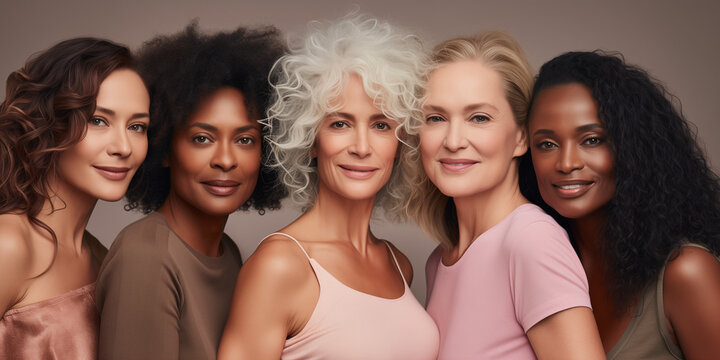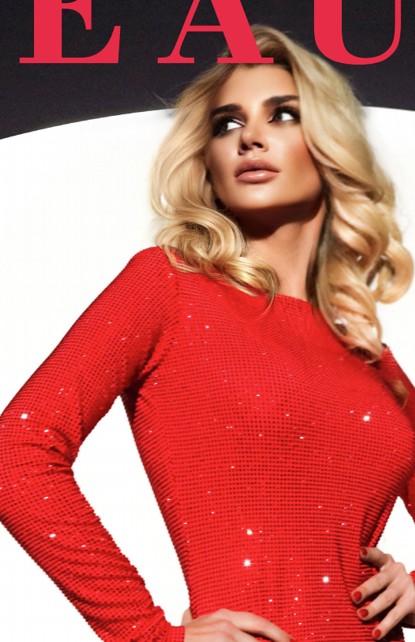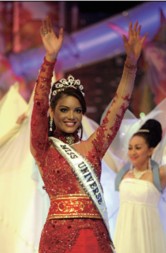
Think about the following questions.
1. What is the first thing you usually notice about another person? Why?
2. What body shapes are considered most attractive in your culture?
3. Are ideas about beauty in your culture different from those in other cultures?
VOCABULARY PREVIEW
Match each New Academic Word List(NAWL) word with the correct definition.
- tribe
- thesis _____
- adaptive _____
- conceive _____
- hormone _____
- enormously _____
- a. greatly in size, extent, or amount
- b. to become pregnant
- c. a natural substance produced in the body that influences how the body grows or develops
- d. an idea to be proved; a theory
- e. a group of people that includes many families who have the same language, customs, and beliefs
- f. the ability of a plant or animal to improve in order to survive in a particular place or situation
IDEAS ABOUT BEAUTY

Researchers have found convincing evidence that people around the world tend to rate beauty in much the same way. Groups from different cultures do not really show that much difference in judging the main factors of beauty. However, researchers do not agree on whether genetics1 or culture has the bigger influence on people's judgments.
Devendra Singh, a psychologist at the University of Texas, conducted an experiment in 1993 to find out if different men found different female body shapes attractive. Dr. Singh gave drawings of different female body shapes to a group of men. Then he asked them to choose the most attractive body shape. The men in the study came from a wide range of cultural backgrounds. Even so, they all tended to rate the "hourglass2" shape as the most attractive. In fact, Dr. Singh found that any woman whose waist3 was seventy percent as wide as her hips was judged as attractive by most men. This was true no matter how big the woman was overall. Body shape, not weight, seemed to be the critical factor for the men in this survey.
Dr. Singh explained this result in terms of evolution. Women with an hourglass shape tend to have higher levels of estrogen, a female hormone, than women who do not have this body shape. Higher estrogen levels also increase fertility, the ability to conceive and give birth to children. Thus, Dr. Singh argues, the men who choose this type of woman have a better chance of having healthy kids. This means that over time, their preference would be adaptive. That is, evolution would favor men who have genes for the selection of these especially fertile women.
Douglas Yu, a biologist at Imperial College in London, disagrees with Dr. Singh's conclusions4. Dr. Yu thinks that cultural ideas of beauty, especially those spread by mass5 entertainment and advertising, have enormously influenced how men judge attractiveness. In order to test his thesis, Dr. Yu traveled to southeast Peru to interview men in a remote6 tribe. These people live far from the reach of the television, movies, and magazines of the industrialized world. Dr. Yu found that the men in this isolated7 community preferred heavier women with wider waists than those preferred by the men in Dr. Singh's study. Because this small community has lived without mass communication, their own culture has not been influenced by outside standards of beauty.
In order to check the reliability of his study, Dr. Yu surveyed two other groups of men from the same tribe. The second and third groups surveyed by Dr. Yu had more exposure8 to mass entertainment and advertising. The results of these later surveys showed that as men from this isolated tribe came into contact with movies and ads, their standards of beauty began to change more toward those of the industrialized world. Dr. Yu concluded from these findings that even if evolution played a part in men's selection of mates, cultural influences are more powerful in the end. Nowadays, both satellite communication and the internet are flooding every corner of the world with images and information from almost every culture. It is becoming harder and harder to find isolated communities. Soon it may be impossible to prove which side is correct in the genetics- versus-culture debate, simply because there will be no uninfluenced groups left to ask.
New Academic Word List
- genetics1 : n. the scientific study of how genes control the characteristics of living things
- hourglass 2 : n. a glass container with an upper part and a lower part connected by a narrow opening that is used to keep track of time
- waist 3 : n. the middle part of the body between the hips and chest or upper back
- conclusion 4 : n. an opinion or decision that is formed after thought or research
- mass 5 : adj. involving, affecting, or designed for many people
- remote 6 : adj. far away from other people, cities, etc.
- isolated 7 : adj. separate from others; remote
- exposure8 : n. the fact or condition of being affected by something or experiencing something
READING COMPREHENSION
A ‣ Mark each statement as true (T) or false (F) according to the reading.
- The men in Dr. Singh's study came from a single culture.
- True
- False
- Dr. Singh thinks evolution has led men to find the hourglass shape attractive.
- True
- False
- Dr. Yu and Dr. Singh are in agreement about how beauty standards form.
- True
- False
- Both studies in this reading used surveys to collect data.
- True
- False
- In his research, Dr. Yu did not include men who had watched movies.
- True
- False
B ‣ Choose the best answer according to the reading.
- What is the main topic of the reading?
- a. Research on how people judge beauty
- b. Describing the most beautiful body shape
- c. The ways that beauty has changed over time
- d. Listing one culture's ideas of beauty
- What did the men in Dr. Singh's survey rate as more important than weight?
- a. Breast and hip size
- b. Breast and waist size
- c. Waist and hip size
- d. Hip and leg size
- In paragraph 2, the word critical is closest in meaning to _____.
- a. negative
- b. important
- c. particular
- d. dangerous
- Which of the following is true of the men in Dr. Yu's research?
- a. They came from three different tribes.
- b. Some of them came from industrialized countries.
- c. All three groups agreed on their standards of female attractiveness.
- d. Those who had seen more mass media had different standards.
C ‣ Look for the answers in the reading and write them on the lines.
- What does the "hourglass" body shape imply about a woman, according to Dr. Singh?
_____ - Why might Dr. Yu's study be difficult to do again?
_____
SUMMARY
Fill in the blanks with the phrases in the box.
- genetics and culture
- evolutionary explanation
- industrialized countries
- hourglass shape
- remote tribe
- cultural backgrounds
|
Research on Beauty Standards |
|
|
Dr. Singh
|
Dr. Yu
|
| Both 6 _____ may play a role. | |
VOCABULARY PRACTICE
Fill in the blanks with the words in the box. Change the form if necessary.
- thesis
- adaptive
- enormously
- tribe
- hormone
- conceive
- The ability to run fast is _____ for many animals because it allows them to escape from predators.
- The Sioux are one of the largest and best-known Native American _____ .
- The _____ of my research paper is that musical ability and math ability are related.
- The male _____ testosterone affects muscle size and strength, as well as mood and aggressiveness.
- When they were unable to _____ , the couple went to a doctor for help.
- The safety of automobiles has improved _____ over the last century.
SUPPLEMENTAL READING
A Beauty Academy

Venezuela may make most of its money from exporting oil, but the country is probably better known for exporting beauty pageant stars. No other country comes close to matching Venezuela's record for sending winners to the Miss World and Miss Universe contests.
How has a country with only twenty-eight million people done it? The answer is probably connected to the Miss Venezuela Academy. This is a special school for Miss World and Miss Universe contestants run by Osmel Sousa for almost four decades until his retirement in 2018. Continuing his work, the school's staff find women in dance clubs, in shopping centers, in schools, and on the sidewalks to apply for the school. Other women come to the school on their own.
The school has strict criteria as to who can enter. The women must be between the ages of seventeen and twenty-four, be at least 1.7 meters tall, and have the ability to answer difficult contest questions. And one more thing: they have to look the "right" way in a swimsuit—and be willing to have plastic surgery to achieve that. The finalists for the school are chosen in March so that the school's special plastic surgeons have time to do their work. The women must be fully recovered from their operations by September, when the contests begin.
The Miss Venezuela Academy has survived both the departure of Osmel Sousa and the coronavirus pandemic. A graduate of the school, Alejandra Conde, was crowned Miss Venezuela 2020 after a mostly "virtual" competition.
Fill in the blanks with information from the reading.
- Many Venezuelan beauty pageant _____ have studied at the Miss Venezuela Academy.
- The school's staff decide who they will train based on strict _____.
- A contestant trained at the school was _____ Miss Venezuela in 2020.

Leave a comment
Load more